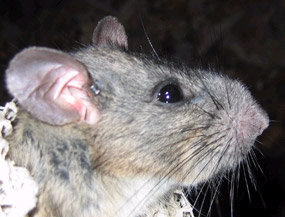|
You are viewing ARCHIVED content published online before January 20, 2025.
Please note that this content is NOT UPDATED, and links may not work. For current information,
visit https://www.nps.gov/aboutus/news/index.htm.
Contact: Matt Varner, 304 465-6542

“The National Park Service (NPS) has been surveying the Gorge for woodrats since 2001,” reports Cal Hite, Superintendent of NRGNR. “By collecting habitat and population information for the woodrat, the NPS hopes to help answer why this species is disappearing in other parts of its range.” “We live-trap the woodrats, then mark each animal with a tiny, numbered, metal ear tag,” explains Matt Varner, NPS wildlife biologist. “The marked woodrats are then released to become available for recapture in subsequent months or years, allowing us to acquire data on population levels. Based on catch rates over the past 5 years, woodrat populations within the park appear to be stable. Unfortunately, woodrat populations in other states continue to dwindle.” In decline for the last 50 years, this species is now absent in Connecticut, New York and much of Pennsylvania and New Jersey. Although this trend has been well documented, the reasons behind the decline remain largely uncertain. Several theories exist which include: 1) severe winter weather, 2) a decline in acorns due to defoliation of oak trees by gypsy moths which reduces the woodrats' winter food supply, 3) parasitic raccoon roundworm infection, and 4) habitat loss or alteration. The Allegheny woodrat feeds on a variety of buds, leaves, stems, fruits, seeds, acorns and other nuts. Unlike the Norway rat, Allegheny woodrats generally have only one litter per year, which averages only 2 young and their average life span is 3-5 years. |
Last updated: February 26, 2015
